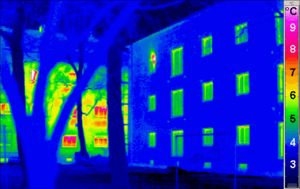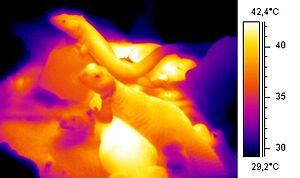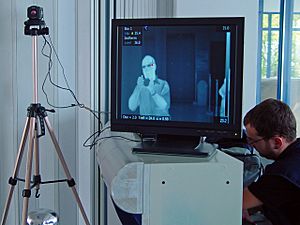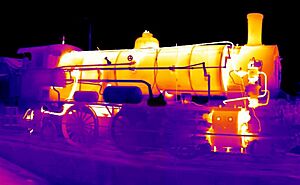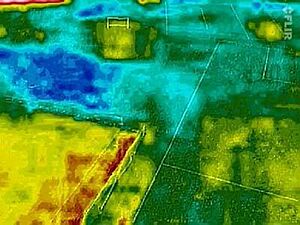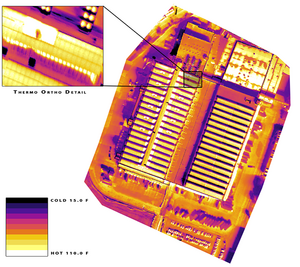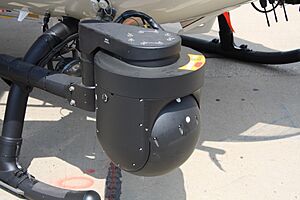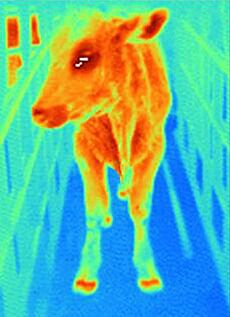Thermography facts for kids
Infrared thermography (also called thermal imaging or thermal video) is a cool way to "see" heat. It uses a special camera called a thermal camera. This camera captures the invisible heat (infrared radiation) that objects give off. It then turns that heat into an image you can see, called a thermogram.
Every object that's warmer than absolute zero (the coldest possible temperature) gives off infrared radiation. This means thermal cameras can see things even in total darkness! Warmer objects give off more radiation. So, a thermal camera shows you where things are hot and where they are cold. Warm things, like people or animals, really stand out against cooler backgrounds, day or night. This makes thermal imaging super useful for things like surveillance and finding people.
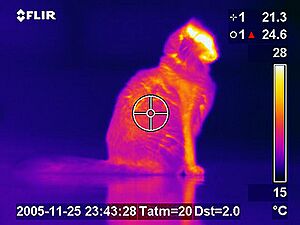
Thermal imaging can also help doctors and vets. It can show changes in body temperature in people and animals. This helps them find problems or check on health. For example, it's used in veterinary medicine for animals. During the 2009 swine flu pandemic, thermal cameras were even used at airports. They helped find people with high body temperatures, which could be a sign of the virus.
Thermal imaging has been around for a long time. But it has become much more common in the last 50 years. Firefighters use it to see through smoke. It helps them find people and locate the hottest parts of a fire. Technicians use it to find hot spots in power lines. These hot spots can mean a part is about to break. Builders use it to find places where heat is escaping from buildings. This helps them make homes more energy-efficient.
Modern thermal cameras often look like regular camcorders. Sometimes, just seeing the live heat image is enough. You don't always need to record it.
Contents
How Thermal Cameras See Heat
Thermal images, or thermograms, show all the infrared energy an object gives off, lets through, and reflects. It's like a heat map! Because heat comes from different places, it can be tricky to get an exact temperature reading. The camera uses smart computer programs to create a temperature image. Remember, it's an estimate of the temperature. The camera gathers information from around the object to figure it out.
Think of it this way:
- The heat the camera "sees" is a mix of:
- Heat the object itself is giving off (what we usually want to measure).
- Heat that passes through the object from something behind it.
- Heat that bounces off the object's surface from something else.
This happens all the time, everywhere. It's called radiant heat exchange. If an object is hotter than its surroundings, it sends heat out to the cooler areas. If an area in the thermogram looks cool, it means that object is absorbing heat from warmer things around it.
What is Emissivity?
Emissivity is how well a material can give off heat radiation. It's a property of the material itself. Emissivity can range from 0 (meaning it doesn't give off any heat) to 1 (meaning it gives off all the heat it can). For example, shiny silver has a very low emissivity (0.02). Asphalt, like on roads, has a high emissivity (0.98).
A "black body" is a perfect theoretical object. It has an emissivity of 1 and gives off heat perfectly based on its temperature. A normal object gives off less infrared radiation than a perfect black body. So, emissivity is the ratio of how much heat an object actually gives off compared to how much it could possibly give off.
Different materials have different emissivities. This can also change with temperature and the type of infrared light. For instance, clean metal surfaces give off less heat at longer infrared wavelengths.
How Thermal Cameras Measure Temperature
A thermal camera uses math to create a visible image. This is because it "sees" electromagnetic radiation that our eyes can't. The final image can be saved as a picture file, like a JPG.
The amount and type of heat radiation depend a lot on an object's surface temperature. This is how a thermal camera can show an object's temperature. But other things also affect the radiation, which can make the measurement less exact. For example, the radiation also depends on the object's emissivity.
To measure temperature without touching the object, you need to set the camera's emissivity correctly. If an object has low emissivity, the camera might think it's colder than it is. This is because the camera only detects the heat the object emits. For a quick guess, a thermographer (someone who uses thermal cameras) might look up the emissivity for that type of object in a table. Then they enter that value into the camera. The camera then calculates the object's temperature based on the emissivity and the heat it detects.
For a more accurate measurement, a thermographer might put a special material on the object's surface. This material has a known, high emissivity. It could be a special spray or even just black insulation tape, which has an emissivity of about 0.97. Then, the object's temperature can be measured using the known emissivity of the tape. If needed, you can then figure out the object's actual emissivity (on a part not covered by the tape). You do this by adjusting the camera's setting until it matches the known temperature. Sometimes, it's too dangerous or hard to do this test. In those cases, the thermographer has to rely on the tables.
Other things can also affect the measurement. These include how much the air absorbs the radiation and the air's temperature. Also, heat from the surroundings can reflect off the object. All these factors affect the final temperature shown by the camera.
Color Scales in Thermal Images
Thermal camera images usually look like they're in one color (monochrome). This is because the camera's sensor doesn't usually tell the difference between different infrared wavelengths. Our eyes see different wavelengths as different colors. But outside of visible light, colors don't have the same meaning.
Sometimes, these single-color images are shown in pseudo-color. This means that changes in color are used to show changes in the heat signal, instead of just changes in brightness. This is helpful because even though humans are good at seeing differences in brightness overall, it's hard to see small differences in very bright areas.
When measuring temperature, the hottest parts of the image are usually white. Medium temperatures are red and yellow. The coolest parts are black. A scale should always be shown next to a pseudo-color image. This scale tells you what temperatures the different colors represent.
Types of Thermal Cameras
A thermographic camera (also called an infrared camera or thermal imaging camera) is a device that creates an image using invisible infrared (IR) radiation. It's similar to a regular camera that uses visible light. But instead of seeing light from 400 to 700 nanometres, infrared cameras see wavelengths from about 1,000 nm (1 micrometre) to 14,000 nm (14 μm). Using and studying the information from these cameras is called thermography.
Thermal cameras change the energy from far infrared light into a visible image. All objects warmer than absolute zero give off thermal infrared energy. So, thermal cameras can "see" all objects, no matter how dark it is. However, most thermal cameras are sensitive to objects warmer than about -50°C.
Thermal cameras have lower image quality than regular cameras. They often have resolutions like 160x120 or 320x240 pixels. More expensive ones can go up to 1280x1024 pixels. Thermal cameras are also much more expensive than regular cameras. High-end models are often restricted from being sold to other countries. This is because the technology can be used by the military.
Cooled Infrared Detectors
Some thermal cameras use "cooled" infrared detectors. These detectors are kept very cold, often in a special vacuum-sealed case. They need to be cooled for the special materials inside them to work. Most modern cooled detectors work at temperatures between -213°C and -173°C.
Without cooling, these sensors would be "blinded" by their own heat. The downside of cooled infrared cameras is that they are expensive to make and use. Cooling takes a lot of energy and time. The camera might need several minutes to cool down before it can start working.
Even though they are bulky and expensive, cooled infrared cameras give much better image quality. This is especially true for objects that are at or below room temperature.
Uncooled Infrared Detectors
Uncooled thermal cameras use sensors that work at room temperature. Or they might be kept at a temperature close to room temperature using small heaters. Modern uncooled detectors work by sensing tiny changes in electrical resistance, voltage, or current when they are heated by infrared radiation. These changes are then measured.
In uncooled detectors, the temperature differences at the sensor are very small. A 1°C difference in the scene only causes a 0.03°C difference at the sensor. These sensors are also a bit slow to react.
Uncooled infrared sensors can be kept at a steady temperature to reduce image "noise." But they don't need to be cooled to very low temperatures. This means they don't need big, expensive, energy-hungry cooling systems. This makes uncooled infrared cameras smaller and cheaper. However, their image quality is usually not as good as cooled detectors. This is due to how they are made with current technology. An uncooled thermal camera also has to deal with its own heat.
Passive vs. Active Thermography
All objects warmer than absolute zero give off infrared radiation. So, a great way to measure heat changes is to use an infrared vision device. This is usually an infrared camera that can detect radiation in the mid-wave (3 to 5 μm) and long-wave (7 to 14 μm) infrared bands. Unusual temperature patterns on an object's surface can show a problem.
In passive thermography, the things you want to see are naturally hotter or colder than their surroundings. Passive thermography is used for many things. These include watching people and medical diagnosis.
In active thermography, you need an energy source to create a heat difference. This is needed when the parts you are checking are usually the same temperature as their surroundings. Active thermography can also help make images clearer.
Benefits of Thermal Imaging
Thermal imaging shows a visual picture, so you can compare temperatures over a large area. It can capture moving objects in real time. It can find parts that are getting too hot before they break. You can use it to measure or observe in places that are hard or dangerous to reach. It's a test method that doesn't damage the object. It can find hidden problems in pipes and other parts. It can also detect objects in dark areas. It even has some uses in physiotherapy (physical therapy).
Challenges of Thermal Imaging
Good quality thermal cameras can be expensive, often costing $3,000 or more. This is because the sensors have many pixels. However, cheaper models with fewer pixels (like 40x40 up to 160x120 pixels) are available. Fewer pixels compared to regular cameras mean the image quality is lower. This makes it harder to tell nearby objects apart in the same view.
Also, the image refresh rate can vary. Some cameras only update the image 5 to 15 times per second. Others, like the FLIR X8500sc, can update 180 times per second or more.
Many models don't provide the exact heat measurements used to make the image. If you don't correctly set the camera for emissivity, distance, and air temperature, the images won't show accurate temperatures.
Images can be hard to understand accurately for some objects. This is especially true for objects with changing temperatures. However, this problem is less common with active thermal imaging.
Thermal cameras create images based on the heat energy they receive. But the amount of radiation is affected by how much an object gives off (emissivity) and how much light, like sunlight, reflects off its surface. This can cause errors in measurements.
- Most cameras are only accurate to within ±2% or worse when measuring temperature. They are not as accurate as touching the object with a thermometer.
- These methods and tools can only directly detect surface temperatures.
Where Thermal Imaging is Used

Thermal imaging has many uses. Thermal cameras are great tools for keeping electrical and mechanical systems working well in factories and businesses. For example, firefighters use them to see through smoke, find people, and locate the hottest parts of fires. Power line technicians find hot spots in power lines. These hot spots are a clear sign that parts are about to fail. If thermal insulation in a building is bad, building construction technicians can see where heat is leaking. This helps them make heating and air conditioning more efficient.
By using the right camera settings, electrical systems can be checked for problems. It's also easy to find problems with steam traps in steam heating systems.
For saving energy, thermal cameras can show how hot an object really is. They also show what that object is radiating heat towards. This helps find where heat is leaking and where areas are getting too hot.
Cooled infrared cameras are used in big astronomy telescopes. Even telescopes that don't usually look at infrared light use them. Examples include the Spitzer Space Telescope and the James Webb Space Telescope.
For automotive night vision, thermal cameras are also put in some fancy cars. They help the driver see at night. The 2000 Cadillac DeVille was the first car to have this.
In 2016, a thermal camera was first put into a smartphone, the Cat S60.
Uses in Industry and Buildings
In factories, engineering, and research, thermography can be used for:
- Controlling how things are made.
- Developing new products.
- Checking how equipment is doing.
- Finding and fixing problems in electrical systems, like power panels.
- Testing things without breaking them.
- Finding and fixing problems.
- Watching how processes work.
- Checking quality in factories.
- Predicting when machines might break down (early warning).
- Monitoring computer data centers.
- Checking solar power plants.
In building inspections, thermography can be used for:
- Checking roofs, especially flat ones.
- Finding problems in buildings, like heat escaping from walls.
- Finding where pests are hiding.
- Checking building insulation for energy leaks.
- Finding refrigerant leaks.
- Checking how well a home is performing.
- Finding moisture in walls and roofs (which can lead to mold).
- Analyzing the structure of brick walls.
Uses in Health
Some body activities, like fever, in people and warm-blooded animals can be checked with non-contact thermography. This is different from using a regular thermometer that touches the skin.
Health-related uses include:
- Looking at blood flow in the skin.
- Checking for problems with blood vessels in the legs.
- Medical imaging using infrared.
- Thermography (medical) - Medical tests for diagnosis.
- Checking for problems in neck arteries using skin heat maps.
- Special thermal imaging for medical uses.
- Checking for muscle and nerve problems.
- Checking for problems in blood vessels in the head and face.
- Checking for thyroid gland problems.
- Various other conditions related to growth, metabolism, and inflammation.
Uses in Security and Defense
Thermography is often used for surveillance, security, firefighting, police work, and fighting terrorism:
- Checking visitors to a country for illnesses.
- Finding hidden listening devices.
- Search and rescue missions.
- Firefighting operations.
- Surveillance using drones.
In weapons systems, thermography can be used by the military and police to find targets:
- Forward-looking infrared (FLIR) systems.
- Infrared search and track (IRST) systems.
- Night vision devices.
- Infrared targeting systems.
- Thermal weapon sights.
In computer hacking, a "thermal attack" uses heat traces left on touchscreens or keyboards to figure out what someone typed.
Other Uses
Other areas where these techniques are used:
- Creating heat maps.
- Archaeological kite aerial thermography (finding old ruins from the air using heat).
- Thermology (the study of heat).
- Veterinary thermal imaging (for animal health).
- Thermal imaging in ornithology and other wildlife monitoring.
- Nighttime wildlife photography.
- Stereo vision (giving robots "depth perception").
- Chemical imaging (seeing chemicals).
- Volcanology (studying volcanoes).
- Agriculture, like counting seeds.
- Baby monitoring systems.
- Detecting pollution.
- Aerial archaeology (finding ancient sites from the air).
- Flame detectors.
- Meteorology (weather satellites use thermal images to find cloud temperature/height and water vapor).
- In Cricket's Umpire Decision Review System. It helps detect if the ball faintly touched the bat (leaving a heat mark).
- Autonomous navigation (helping robots move on their own).
History of Thermal Imaging
Discovery of Infrared Radiation
Infrared light was discovered in 1800 by Sir William Herschel. He found it was a type of radiation beyond red light. These "infrared rays" were mainly used to measure heat. Scientists developed detectors, mostly thermometers, until World War I. A big step happened in 1829 when Leopoldo Nobili created the first thermocouple. This was an improved thermometer. Later, in 1833, Macedonio Melloni made an even better tool. It could detect a person 10 meters away!
The next big improvement was the bolometer, invented in 1880 by Samuel Pierpont Langley. By 1901, his bolometer could detect heat from a cow 400 meters away. It was sensitive enough to detect temperature differences of just 0.00001°C. The first commercial thermal imaging camera was sold in 1965. It was used to check high voltage power lines.
First Thermal Cameras
In 1929, Hungarian physicist Kálmán Tihanyi invented an infrared-sensitive television camera. It was for anti-aircraft defense in Britain. The first American thermal camera was an infrared line scanner. The US military and Texas Instruments created it in 1947. It took one hour to make just one image!
Later, in the mid-1950s, the British developed their first infrared linescan system called Yellow Duckling. This system used a spinning mirror and detector. It was meant to find submarines but was used for land surveillance instead.
This technology got better when scientists found that mercury cadmium telluride needed much less cooling. In 1969, Michael Francis Tompsett in the UK patented a camera that scanned electronically. It became very good after more improvements in the 1970s. Tompsett also suggested the idea for solid-state thermal imaging sensors. These ideas eventually led to the modern thermal cameras we have today.
Using special video camera tubes with materials like triglycine sulfate made cameras sensitive to a wide range of infrared light. This technology was a step towards modern microbolometer cameras. It was mainly used in firefighting thermal cameras.
Smart Sensors
One important area of development was making security systems "smart." This meant they could understand signals and warn about threats. "Smart sensors" started to appear. These sensors could combine sensing, signal processing, and understanding.
By the late 1990s, infrared technology started being used more by regular people. The cost of uncooled sensors dropped a lot. This, along with many new developments, led to a market for both civilian and military uses. These uses include checking the environment, analyzing buildings and art, medical tests, and helping cars drive and avoid crashes.
See Also
- Infrared and thermal testing
- Infrared camera
- Infrared detector
- Infrared photography
- Infrared thermometer
- Night vision
- Non-contact thermography
- Thermal imaging camera (firefighting)
- Thermographic inspection


